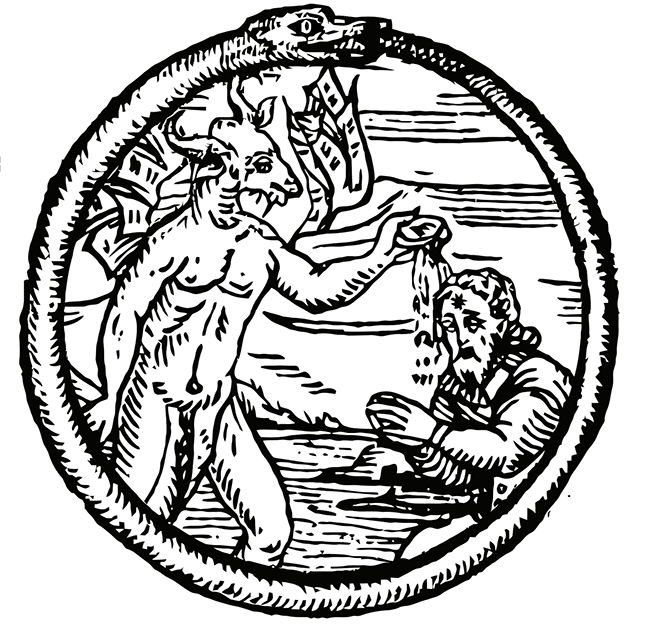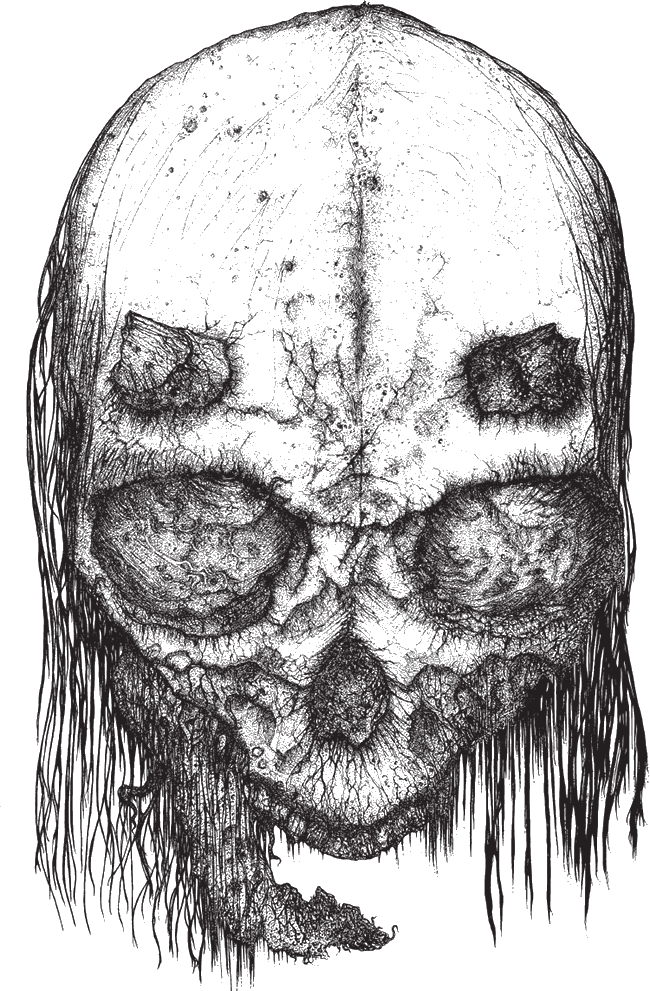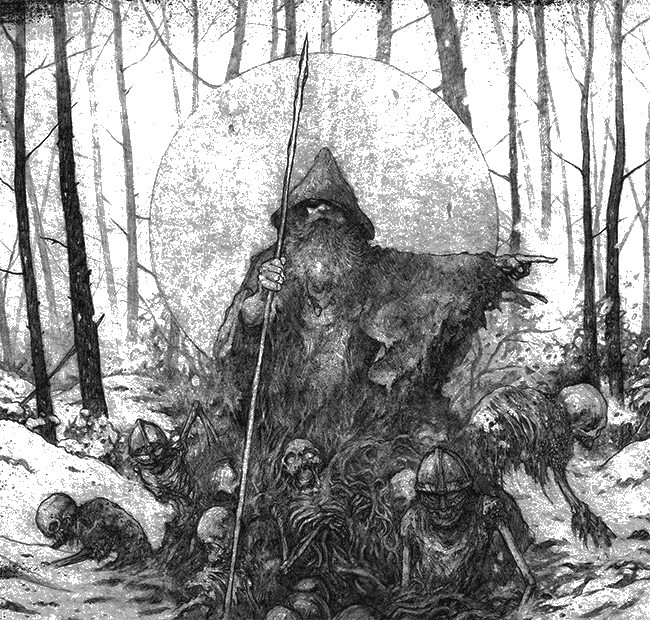Dayal Patterson (Cult Never Dies)
2019-12-12
by Niklas Göransson
Dayal Patterson – British writer and connoisseur of underground metal literature – discusses the conception of as well as philosophies behind his publishing house and merchandise company, Cult Never Dies.
The following is an excerpt from the full article, which is twice as long and published in Bardo Methodology #5. The same issue also includes conversations with BLASPHEMY, DAUTHA, CLANDESTINE BLAZE, ACRIMONIOUS, ROME, LYCHGATE, MORBOSIDAD, Nuclear War Now!, MYSTIFIER, W.A.I.L., WINTERFYLLETH, and PHURPA.

– Our newest book, Non Serviam: The Official Story of Rotting Christ, came out late November 2018. It was co-written by Sakis Tolis of ROTTING CHRIST and also features contributions from Themis Tolis, former members Morbid and Jim Mutilator, as well as musicians from other bands such as ENSLAVED, WATAIN, MYSTIFIER, SEPTIC FLESH, MOONSPELL, MAYHEM, DEATH COURIER and TIAMAT.
Dayal adds that there’s a bit more to this Hellenic expedition, as the next book in his ‘black metal cult’ series – which currently consists of Black Metal: Evolution of the Cult, Cult Never Dies Vol. One and Into the Abyss respectively – will feature Greek bands such as NECROMANTIA, AGATUS, ZEMIAL, MACABRE OMEN, and MEDIEVAL DEMON.
– These Greek acts will be appearing alongside bands from either one or two other countries, most likely Sweden and the US. This is the structure I prefer for my black metal books, placing together two or three loosely connected groups, organised by country of origin, musical style, etcetera – I think it allows for a good balance of continuity and variation, and limits neither myself nor the reader to any one subject. On the other hand, I’d quite like to one day do a book focussing on, say, Greek underground metal and look at that alone. But then I think I’d assemble it quite differently and probably break away from the one-band-per-chapter format I use currently, and these very long and broad in-depth interviews.
I’m curious whether Dayal regards himself as a journalist or if he prefers a different term, such as writer. I personally detest being subjected to the former, almost as much as I loathe people who write reviews for modest online publications and as a result wish to be referred to as such.
– I agree! I never call myself a journalist, partly due to what you mentioned and also for the opposite reason: I associate ‘journalism’ with something larger and more external, in this context people who report on metal for the benefit of the wider world, as opposed to those who write within the movement itself. I guess it’s all semantics. Within Cult Never Dies I definitely prefer ‘writer’, not least because I think a lot of journalists dealing with metal have very different motives and approaches and probably also a very different outlook on music and metal in general. I’d like to think that Cult Never Dies is essentially part of the underground metal literature canon which mostly sidesteps the ‘media machine’, whereas a lot of metal journalists are clearly either part of that machine or rather keen to be so in the future. That said, some of the writing I’ve done in the past – and still do to a lesser extent – would fall fairly squarely under journalism, most obviously some of the pieces I contributed to Metal Hammer.
Five years ago, Dayal supported himself both as a freelance writer, mostly for Metal Hammer UK, and by working in a studio three days per week doing graphic design and retouching. When Cult Never Dies was founded, mostly as a passion project, he had no plans of making any sort of living from it.
– I released my first book, Black Metal: Evolution of the Cult, on American publisher Feral House in very late 2013 and simultaneously self-published what was effectively the first Cult Never Dies release, Black Metal: Prelude to the Cult. This was a fanzine, or mini-book, featuring articles with bands such as TAAKE, CLANDESTINE BLAZE, HADES ALMIGHTY, IMPALED NAZARENE, and ENTHRONED – material that didn’t fit into the wordcount for Evolution or interviews published in my earlier ’zines which had been referenced in the main book. So, while intrinsically connected to Evolution, it was also a separate publication in its own right.
Dayal recalls his experience with Prelude to the Cult as highly rewarding, especially compared to that of Evolution of the Cult. He notes that while the publishing house did an excellent job in terms of distribution and production values – for example, the book itself is very well-printed – there were other issues leaving a fair bit to be desired.
– Besides having to deal with almost all promotion myself, I also had to dictate the layout by email – a slow and inefficient process. So, in 2015, when the time came to release the sequel to Evolution, it really didn’t make much sense to look for an external partner; firstly, there wasn’t exactly an abundance of publishers from an underground metal background and, secondly, I knew I’d end up handling the design and promotion myself once again. As such, I decided to make it my first full-length book on Cult Never Dies.
Black Metal: The Cult Never Dies Vol. One – the title an obvious nod to his own entity having now been brought to the next level – was published in March 2015. Cult Never Dies recently celebrated its fifth anniversary and, besides the in-house books, now also sell a variety of other metal literature as well as official band merchandise.
– I stopped working at the studio about three years back and, from that point on, started doing Cult Never Dies more or less full-time, with some friends dropping by the office to help out every now and then. Today there are several people involved in the main activities of Cult Never Dies, which gives me more time to focus on creative work. At one point I was essentially writing the books, laying them out, handling the printing and production, promoting them, then processing and finally posting the orders… while also doing a part-time job. Rewarding, but very tiring to be honest! The whole thing has been a fairly organic process and even though it never occurred to me that this might become my full-time job when setting up Cult Never Dies, that’s essentially what happened. But it’s primarily still an outlet to release both my own writing and that of other writers I respect, as well as printing official band merchandise without external interference.

I’m wondering if there was a specific underground publication that really moved Dayal in his youth. While I recall quite a few excellent ’zines – I Came from Darkness, Nordic Vision, Tales of the Macabre, along with a plethora of Swedish ones come to mind – none had quite such a bearing as Slayer #10, the one with AGHAST on the cover. It came out in 1994, when there was still very limited information available about what had really gone down in Norway and featured interviews with essentially all major players who were still breathing.
– Metal ’zines definitely had a strong impact on me; Slayer as you mention, Petrified was another, and also, more specifically, the third issue of the UK ’zine The Dead Sea. I read a lot of ’zines back then – metal, punk, death and goth rock, you name it. I fell in love with the format and even today I don’t necessarily have to be totally interested in the subject matter they feature to appreciate them, though, of course, metal ’zines resonate more with me than anything else. It’s the honesty and ambience of the whole endeavour I find fascinating. As far as underground metal goes, the 90s was such a strong time for fanzines. Until the late 90s there would always be at least one guy outside a venue selling his writings. And from 2005 to 2007 I was one of those guys, selling my own ’zine, Crypt, on the streets of London after shows had ended. Eventually, I was distributing a few other publications I’d gotten from trades as well, so I think I’ve kind of gone full circle now, unconsciously. Although today I no longer sell outside gigs thanks to merch stalls and, most of all, the internet.
Bardo Methodology #4 included conversations with two veterans metal writers, Götz Kühnemund and Louise Brown. Both features touched upon the British metal media – essentially a doomsday analysis from two vastly different perspectives. As such, I thought it might be interesting hearing Dayal’s thoughts on the matter, and whether he even considers himself part of it in the first place.
– My relationship with both the UK and international metal media will have been quite different to that of both Louise and Götz, I’ve only ever been involved as a freelancer and so dealt far less with the behind-the-scenes machinery that keeps it all rolling forward. There were a couple of occasions when the possibility arose to work in the magazine headquarters full-time, but a large part of the reason I pursued writing and photography in the first place was to avoid sitting in an office. Also, working full-time for a high street magazine – in the UK at least, but probably elsewhere too – necessitates becoming part of the media industry in a way which probably wouldn’t suit me particularly well. I enjoy being able to work in that world periodically but wouldn’t say I belong there; I generally feel more in common with musicians, visual artists and people behind small labels than music journalists, managers, and PR people. Creating books has only confirmed that to me, so working directly with labels and bands suits me well.
That said, during his time as an active freelance writer – leading up to Evolution of the Cult and the establishment of Cult Never Dies – he certainly kept busy.
– I must at least say that it offered a fascinating window into a world I’d never have expected to be part of when starting my first ’zine. It was very interesting and generally enjoyable to travel – and in the early days at least, there were a lot of paid travel opportunities – for face-to-face interviews with bigger artists. Some examples being Tony Iommi, Alice Cooper, SAXON, DESTRUCTION, RAMMSTEIN, CARCASS, VENOM, KILLING JOKE, ALICE IN CHAINS, PARADISE LOST, Rob Zombie, TWISTED SISTER… even non-musicians like Brian Blessed and Jason Momoa. I think it’s fair to say that I’m unlikely to have ever crossed paths with most of these people had I only been doing Crypt or Cult Never Dies. Some of the assignments were very interesting; for example, being in the studio while WATAIN were recording, touring with bands such as DIMMU BORGIR and MACHINE HEAD, seeing the Finnish countryside with TURISAS, visiting MARDUK in Sweden, going to places like Ibiza, Germany, and Turkey to cover festivals. Even racing ‘round the Nurburgring with RAGE. It offered an interesting counterpart to the underground metal stuff I’d continued to be involved in as a writer and promoter.
Dayal adds that while not necessarily having been the biggest fan of all the bands involved, he’s always been more inclined to write interviews rather than reviews.
– With Cult Never Dies I basically only deal with artists whose work I am very interested in, but I think regularly interviewing musicians I was perhaps more critical of actually helped me, as a writer, to try and dig deeper into the mindsets of the musicians I’m talking to – exploring their motivations, influences and worldviews, which were perhaps quite different to mine. And I have to say that although the business element is obviously much, much bigger in high street magazines than within the underground, I never experienced a huge amount of interference. For example, none of the reviews I submitted were ever changed to please a label, even if they were advertisers, and bigger bands would sometimes receive less than flattering evaluations so I don’t believe things are quite as corrupt as some think. Of course, many of the bands that interested me would not be widely known enough to receive a very long and in-depth interview in magazines like Metal Hammer, Decibel, or even Terrorizer so it was always necessary for me to have my own outlet as well. Today, that outlet takes up most of my time but I’m happy to have been able to dip my toes in that other world, more or less on my own terms.

This was an excerpt from the full article, which is twice as long and published in Bardo Methodology #5. The same issue also includes conversations with BLASPHEMY, DAUTHA, CLANDESTINE BLAZE, ACRIMONIOUS, ROME, LYCHGATE, MORBOSIDAD, Nuclear War Now!, MYSTIFIER, W.A.I.L., WINTERFYLLETH, and PHURPA.



